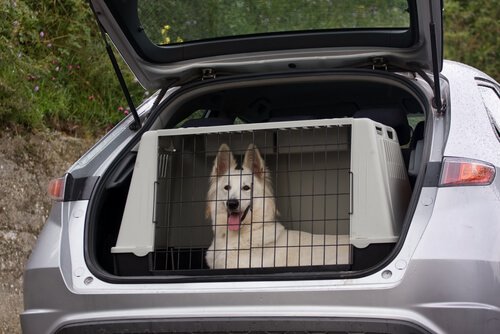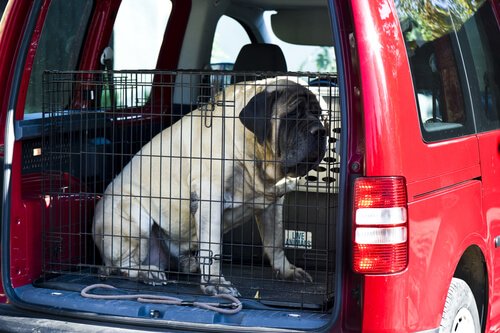What's the Best Way to Transport a Pet?

Whether you’re going on vacation, moving, or just taking your pet to the vet, it’s always best to have a reliable way to transport your pet. This all depends on several things, like regulations (especially for the first two), size, the form of transport, and where exactly you’re taking your pet to.
The best way to transport a pet in your car
If you have a car, there are a few things you need to consider when it comes to the comfort and safety of both the humans and animals inside the vehicle.
If you let your pet loose in the car, they could go down by the pedals, distract you, or block your vision, which obviously increases the risk of getting inro an accident.

So, traffic laws say that pets have to be restrained within your car to keep them from falling, sliding around, or doing anything to distract the driver. It’s best for your pet to be in the back seat or trunk, as long as it’s a hatchback so that you don’t risk suffocating your pet.
If you have to transport your pet, regardless of the destination or the way you’re transporting them, you need to always consider the comfort and safety or both the humans and animals.
What to use to transport a pet in your car
There are lots of great tools for transporting a pet in the car. These can also change a lot depending on the size and traits of the animal. For example:
- A carrier is great for cats and small dogs. It’s best to put them on the floor, either in front of the back seats or snug in the trunk.
- You can also use a crate if you have a bigger dog. The only easy place to put it is in the trunk.
- You need to use a harness with two hooks to keep it from flying forward if you get in an accident. It’s necessary figure out a way to anchor them in so that the crate or carrier doesn’t move.
You should also put a divider between the front and back seats or back seats and trunk.
Pet travel conditions for other modes of transportation
If you decide to take your pet with you on a train, bus, plane, or boat, you need to check with the specific company or service to see if they have any requirements or restrictions. They usually aren’t the same between one company and another, so it’s best to play it safe. For example:
- Some airlines let you bring pets into the cabin in a carrier, if they’re small. If they’re big, they will be placed in the plane cargo.
- Trains will allow dogs, cats, ferrets, and birds — except for poultry like chicken — as long as they weigh under 23 pounds.
- Most boats allow pets, but they have specific places where you have to put the cages and carriers.
- Buses only allow pets to be placed in the cargo, except for service or guide dogs.
What to do if you’re traveling abroad with a pet
If you’re bringing a pet with you abroad, you’ll also need to look up the rules and regulations in each of the places you’re going.
Within Europe, there shouldn’t be any problems with dogs, cats, or ferrets, as long as you have their health and passport up-to-date, and they have a chip.
But when it comes to international trips, you want to avoid any unpleasant surprises when you get your feet on the ground. So, make sure your pet takes care of their beforehand.
Transporting pets is also a business

If you want to avoid all the worrying and headache of transporting a pet, regardless to who or where, there are also companies that specialize in doing just this.
They can completely guarantee the safety and comfort of the animals they transport. They have:
- A caretaker constantly supervising the animal.
- Veterinarian care.
- Carriers that are big enough for your pet to move around.
- GPS tracking.
- Stops every four hours for ground-based trips.
For international trips, airline companies have specific places for the animals pass their delays and hotels that will take care of them. That way, your little friend will be as comfortable as possible while they’re waiting for you to come get them.
Whether you’re going on vacation, moving, or just taking your pet to the vet, it’s always best to have a reliable way to transport your pet. This all depends on several things, like regulations (especially for the first two), size, the form of transport, and where exactly you’re taking your pet to.
The best way to transport a pet in your car
If you have a car, there are a few things you need to consider when it comes to the comfort and safety of both the humans and animals inside the vehicle.
If you let your pet loose in the car, they could go down by the pedals, distract you, or block your vision, which obviously increases the risk of getting inro an accident.

So, traffic laws say that pets have to be restrained within your car to keep them from falling, sliding around, or doing anything to distract the driver. It’s best for your pet to be in the back seat or trunk, as long as it’s a hatchback so that you don’t risk suffocating your pet.
If you have to transport your pet, regardless of the destination or the way you’re transporting them, you need to always consider the comfort and safety or both the humans and animals.
What to use to transport a pet in your car
There are lots of great tools for transporting a pet in the car. These can also change a lot depending on the size and traits of the animal. For example:
- A carrier is great for cats and small dogs. It’s best to put them on the floor, either in front of the back seats or snug in the trunk.
- You can also use a crate if you have a bigger dog. The only easy place to put it is in the trunk.
- You need to use a harness with two hooks to keep it from flying forward if you get in an accident. It’s necessary figure out a way to anchor them in so that the crate or carrier doesn’t move.
You should also put a divider between the front and back seats or back seats and trunk.
Pet travel conditions for other modes of transportation
If you decide to take your pet with you on a train, bus, plane, or boat, you need to check with the specific company or service to see if they have any requirements or restrictions. They usually aren’t the same between one company and another, so it’s best to play it safe. For example:
- Some airlines let you bring pets into the cabin in a carrier, if they’re small. If they’re big, they will be placed in the plane cargo.
- Trains will allow dogs, cats, ferrets, and birds — except for poultry like chicken — as long as they weigh under 23 pounds.
- Most boats allow pets, but they have specific places where you have to put the cages and carriers.
- Buses only allow pets to be placed in the cargo, except for service or guide dogs.
What to do if you’re traveling abroad with a pet
If you’re bringing a pet with you abroad, you’ll also need to look up the rules and regulations in each of the places you’re going.
Within Europe, there shouldn’t be any problems with dogs, cats, or ferrets, as long as you have their health and passport up-to-date, and they have a chip.
But when it comes to international trips, you want to avoid any unpleasant surprises when you get your feet on the ground. So, make sure your pet takes care of their beforehand.
Transporting pets is also a business

If you want to avoid all the worrying and headache of transporting a pet, regardless to who or where, there are also companies that specialize in doing just this.
They can completely guarantee the safety and comfort of the animals they transport. They have:
- A caretaker constantly supervising the animal.
- Veterinarian care.
- Carriers that are big enough for your pet to move around.
- GPS tracking.
- Stops every four hours for ground-based trips.
For international trips, airline companies have specific places for the animals pass their delays and hotels that will take care of them. That way, your little friend will be as comfortable as possible while they’re waiting for you to come get them.
This text is provided for informational purposes only and does not replace consultation with a professional. If in doubt, consult your specialist.








